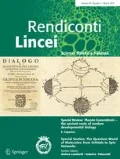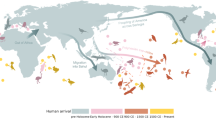Abstract
Mass extinctions are a major pattern in macroevolution. Because of their frequency, quickness and global effects, they shaped the global biodiversity several times during the geological ages. As an integrative factor with respect to microevolutionary Neo-Darwinian processes, mass extinctions are probably due to a set of different possible causes (basaltic super-eruptions, impacts of asteroids, global climate changes, continent drifts, and so on). An analogy has been proposed. If we compare the rates and amounts of extinction during those singular evolutionary events with the range of species losses over the past few centuries and millennia in human times, we see a similar trend. Then, according to a group of authoritative evolutionists like Edward O. Wilson and Niles Eldredge, we have evidence that humans are now causing the so called “Sixth Mass Extinction”. “Anthropocene” also means that Homo sapiens has become a dominant evolutionary force. Through a mix of different significantly impacting activities (i.e., fragmentation of habitats, overpopulation, chemical pollution, invasive species, over-exploitation of resources in hunting and fishing), we have produced the conditions for a serious extinction crisis. According to Nature (March 2011), the sixth mass extinction is under way: “we find that Earth could reach that extreme within just a few centuries if current threats to many species are not alleviated” (Barnosky et al. 2011). We discuss here a recent model for mass extinctions (the “Perfect Storm Model”), based on the idea that these macroevolutionary patterns could be produced by a mix of three main simultaneous causes and conditions.

Similar content being viewed by others
References
Alvarez W (1997) T-Rex and the Crater of Doom. Princeton University Press, Princeton
Alvarez L, Alvarez W, Asaro F, Michel HV (1980) Extraterrestrial cause for the Cretaceous-Tertiary extinction. Experimental results and theoretical implications. Science 208:1095–1108
Archibald JD et al (2010) Cretaceous extinctions: multiple causes. Science 328:973
Arens NC, West ID (2008) Press-pulse: a general theory of mass extinctions? Paleobiology 34:456–471
Bambach RK (2006) Phanerozoic biodiversity mass extinctions. Annu Rev Earth Planet Sci 34:127–155
Barnosky A et al (2011) Has the Earth’s sixth mass extinction already arrived? Nature 471:51–57
Benton MJ (2003) When life nearly died. Thames & Hudson, London
Bostrom N, Ćirković MM (eds) (2008) Global catastrophic risks. Oxford University Press, Oxford
Brook BW, Sodhi NS, Bradshaw CJA (2008) Synergies among extinction drivers under global change. Trends Ecol Evol 23:453–460
Butchart SHM et al (2010) Global Biodiversity: indicators of recent declines. Science 328:1164–1168
Cavalli Sforza LL (2010) La specie prepotente. Editrice San Raffaele, Milano
Cavalli Sforza LL, Pievani T (2012) Homo sapiens. The Great History of Human Diversity. Codice, Turin
Clemens ES (1986) Of asteroids and dinosaurs. The role of the press in the shaping of scientific debate. Soc Stud Sci 16:421–456
Courtillot V, Allegre C (1999) Evolutionary catastrophes: the science of mass extinction. Cambridge University Press, Cambridge
Darwin CD (1836–1844) Charles Darwin’s Notebook. In: P.H. Barrett et al. (ed). Cornell University Press, Ithaca
de Boer JZ, Sanders DT (2002) Volcanoes in human history. The far-reaching effects of major eruptions. Princeton University Press, Princeton
Eldredge N (1995) Dominion. Holt and Co., New York
Eldredge N (1998) Life in the balance. Princeton University Press, Princeton
Eldredge N, Pievani T (2010) Ecosphera (Ed) Il futuro della Terra. UTET De Agostini, Torino
Frankel C (1999) The end of the dinosaurs. Chicxulub crater and mass extinctions. Cambridge University Press, Cambridge
Glen W (ed) (1994) Mass-extinction debates: how science work in a crisis. Stanford University Press, Stanford
Gould SJ (1985) The Flamingo’s smile. Norton, New York
Gould SJ (1987) Time’s arrow. Time’s cycle. Harvard University Press, Cambridge
Gould SJ (1991) Bully for Brontosaurus. Norton, New York
Gould SJ (1993) Eight Little Piggies. Norton, New York
Gould SJ (2002) The structure of evolutionary theory. Harvard University Press, Cambridge
Hallam A (1983) Great geological controversies. Oxford University Press, Oxford
Hildebrand AR et al (1991) Chicxulub crater: a possible Cretaceous-Tertiary boundary impact crater on the Yucatán peninsula. Geology 19:867–871
Hsu KJ (1986) The great dying. Ballantine Books, New York
Kareiva P, Watts S, McDonald R, Boucher T (2007) Domesticated nature: shaping landscapes and ecosystems for human welfare. Science 316:1866–1869
Keller G (2008) Cretaceous climate, volcanism, impacts, and biotic effects. Cretac Res 29:754–771
Lawton JH, May R (eds) (1995) Extinction rates. Oxford University Press, Oxford
Leakey R, Lewin R (1992) The sixth extinction: patterns of life and the future of humankind. Doubleday, London
MacPhee RDE (1999) Extinctions in near time. Causes, contexts and consequences. Kluwer Academic Publ, New York
Myers N, Knoll AH (2001) The biotic crisis and the future of evolution. PNAS 98:5389–5392
Novacek MJ (2001) The Biodiversity Crisis: Losing What Counts. The New Press, New York
Palumbi SR (2001) Humans as the world’s greatest evolutionary force. Science 293:1786–1790
Pereira HM et al (2010) Scenarios for global biodiversity in the 21st century. Science 330:1496–1501
Pievani T (2009) The world after charles R. Darwin: continuity, unity in diversity, contingency. Rend. Fis. Acc. Lincei 20(4):355–361
Pievani T (2011) La vita inaspettata. Cortina, Milan
Pievani T (2012) Geoethics and philosophy of earth sciences: the role of geophysical factors in human evolution. Annals Geophys 55(3):349–353
Pievani T (2013) Anatomia di una rivoluzione. La logica della scoperta scientifica di Darwin. Mimesis, Sesto San Giovanni
Pimm S et al (1995) The future of biodiversity. Science 269:347–350
Powell JL (1998) Night comes to the Cretaceous. Harcourt Brace & Co, New York
Raup D (1992) Extinction: bad genes or bad luck?. Norton, New York
Saino N et al (2010) Climate warming, ecological mismatch at arrival and population decline in migratory birds. Proc Royal Soc B. doi:10.1098/rsbp2010.1778
Schulte P et al (2010) The Chicxulub asteroid impact and mass extinction at the Cretaceous-Tertiary boundary. Science 327:1214–1218
Ward PD (1994) The end of evolution: on mass extinctions and the preservation of biodiversity. Bantam Books, New York
Ward PD (2000) Rivers in time. The search for clues to earth’s mass extinctions. Columbia University Press, New York
Weisman A (2008) The World without Us. Picador, London
Wilson EO (2003) The future of life. Vintage, New York
Wilson EO (2010) The diversity of life. Harvard University Press, Cambridge
Author information
Authors and Affiliations
Corresponding author
Rights and permissions
About this article
Cite this article
Pievani, T. The sixth mass extinction: Anthropocene and the human impact on biodiversity. Rend. Fis. Acc. Lincei 25, 85–93 (2014). https://doi.org/10.1007/s12210-013-0258-9
Received:
Accepted:
Published:
Issue Date:
DOI: https://doi.org/10.1007/s12210-013-0258-9




